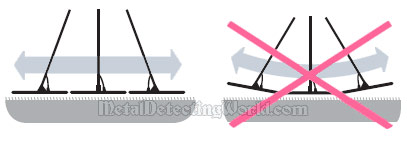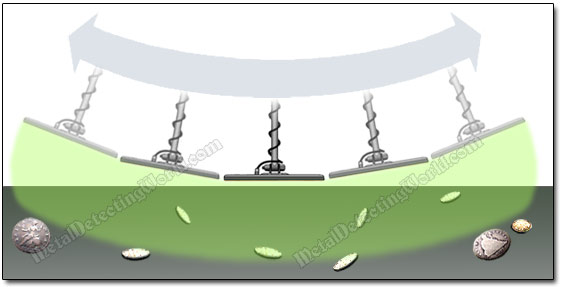Search Coils for Metal Detectors, page 7
Search Coil Discipline in Details:
Sweep Coil Parallel and Close to Ground in Semicircular Pattern, No Pendulum Swinging
2) Keep Search Coil Parallel to the Ground
Keep the search coil parallel to the ground surface at a constant height to eliminate false signals. Sweeping the search coil in a slight semicircular pattern will maintain a more parallel relationship between the ground surface and the search coil.
Sudden upward motions of the search coil can alter the way automated circuitry of your metal detector "sees" ground minerals and rejected targets causing it to react with false audio signals common to some motion metal detectors.3) Keep Search Coil Close to the Ground
Keep the search coil as close to the ground as possible to maintain maximum operational depth range, especially when you are detecting with a small coil.
If you are searching a lawn with no obstacles, keep the coil in light contact with the grass to achieve maximum penetration. When searching uneven ground, keep an even search coil height above the obstacles and increase sensitivity if possible.
4) No Pendulum Swinging!
Do not swing the coil in a pendulum motion so that it arcs upward at the end of a sweep. This will result in false signals, and operational depth will be lost at these points in ground coverage. This will result in missing many valuable targets.

By ending each sweep with the coil's drifting up, a detectorist, to his/her disadvantage, voluntarily narrows the ground coverage that can be scanned effectively. As a result of such uncontrolled swinging, almost 50% of the area is left unsearched.
Arched Electromagnetic Field Detection Pattern Does Not Reach a Few Coins

One can only imagine how many "keeper" targets may be left in the careless detectorist's path that has been only partially searched. This is one of the reasons why we find many good targets at the "searched" sites. Pendulum swinging is used only in situations when a questionable target needs to be identified (more details on page 19).